Unité de Catalyse et de Chimie du Solide site Artois
Faculté des Sciences de Lens
PUBLICATIONS MARQUANTES 2023 :
- «New insight into nanoscale identification of the polar axis direction in organic ferroelectric films»
M. M. Saj Mohan, A. Da Costa, J.-F. Tahon, V. Bouad, A. Hamieh, F. Ponchel, J.-M. Lefebvre, V. Ladmiral, D. Rémiens, R. Desfeux, S. Barrau, A. Ferri
ACS Appl Mater Inter, 2023, 15, 44, 51663–51674 - doi: 10.1021/acsami.3c08579
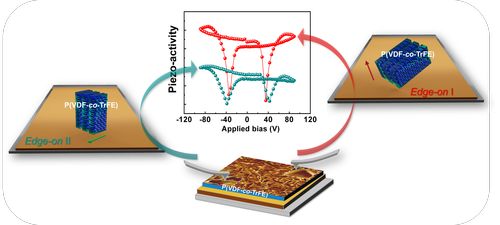 |
| Ferroelectric poly(vinylidene fluoride-co-trifluoroethylene) [P(VDF-co-TrFE)] thin films have been deposited by spin-coating onto the Bi0.5Na0.5TiO3(BNT)/LNO/SiO2/Si heterostructure. The copolymer microstructure investigated by using grazing-incidence wide-angle X-ray diffraction (GIWAXD) and deduced from the (200)/(110) reflections demonstrates that the b-axis in the P(VDF-co-TrFE) orthorhombic unit cell is either in the plane or out of the plane, depending on the face-on or on the two types of edge-on (called I and II) lamellar structures locally identified by atomic force microscopy (AFM). For edge-on I lamellae regions, the electroactivity (dzzeff ~ −50.3 pm/V) is found to be twice as high as that measured for both edge-on II or face-on crystalline domains, as probed by piezoresponse force microscopy (PFM). This result is directly correlated to the direction of the ferroelectric polarization vector in the P(VDF-co-TrFE) orthorhombic cell: larger nanoscale piezoactivity is related to the b-axis which lies along the normal to the substrate plane in the case of the edge-on I domains. Here, the ability to thoroughly gain access to the as-grown polar axis direction within the edge-on crystal lamellae of the ferroelectric organic layers is evidenced by combining the nanometric resolution of the PFM technique with a statistical approach based on its spectroscopic tool. By the gathering of information at the nanoscale, two orientations for the polar b-axis are identified in edge-on lamellar structures. These findings contribute to a better understanding of the structure–property relationships in P(VDF-co-TrFE) films, which is a key issue for the design of future advanced organic electronic devices. |

- «Low Carrier Effective Masses in Photoactive Sr2Sb2O2Q3 (Q = S, Se): The Role of the Lone Pair»
S. Al Bacha, S. Saitzek, P. Roussel, M. Huvé, E. E. McCabe, H. Kabbour
Chem. Mater., 2023, 35, 22, 9528–9541 - doi: 10.1021/acs.chemmater.3c01298
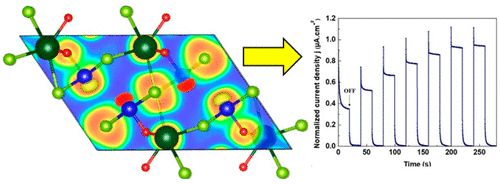 |
| The crystal structure, electronic properties, photocatalytic activity, and photocurrent response of a new antimony oxysulfide Sr2Sb2O2S3 and its oxyselenide analogue Sr2Sb2O2Se3 are presented. Both oxychalcogenides contain heteroleptic SbOQ4 units with stereochemically active 5s2 electron pairs. Our combined experimental and computational study highlights the structure–property relationships in this family of materials. By means of density functional theory calculations, we show very low effective masses for the electrons (me* = 0.191(6) and 0.163(2) m0) and holes (mh* = 0.276(2) and 0.190(2) m0) for the oxysulfide and the oxyselenide, respectively, an indication of very high mobilities. Using DFT calculations, we attribute the low effective mass values (related to the curvature of the bands) to the nature and strength of the bonding between the lone pair electrons and the anions in the studied structure compared with other structure (Sr6Cd2Sb6S10O7). We analyze the states contributing to the lone pair stereoactivity and consequently to the observed photocurrent response and photocatalytic behavior under solar irradiation. This activity, the band gap values, and the band edge positions illustrate the potential of these antimony oxychalcogenides as promising candidates for water splitting using solar energy. Our study unlocks some key features in designing oxychalcogenides with low effective masses, which are advantageous for photocatalysis. |

- «Strong Intermixing Effects of LFO1-x/STOx toward the Development of Efficient Photoanodes for Photoelectrocatalytic Applications»
Y. Nassereddine, M. Benyoussef, N. S. Rajput, S. Saitzek, M. El Marssi and M. Jouiad
Nanomaterials 2023, 13, 2863 - doi: 10.3390/nano13212863
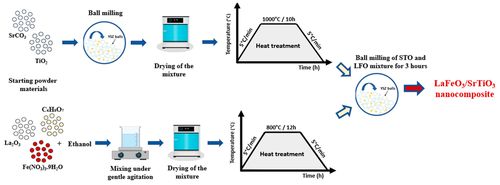 |
| Aiming to improve the photocatalytic properties of transition metal perovskites to be used as robust photoanodes, [LaFeO3]1−x/[SrTiO3]x nanocomposites (LFO1−x/STOx) are considered. This hybrid structure combines good semiconducting properties and an interesting intrinsic remanent polarization. All the studied samples were fabricated using a solid-state method followed by high-energy ball milling, and they were subsequently deposited by spray coating. The synthesized compounds were demonstrated to possess orthorhombic (Pnma) and cubic (Pm3¯ m) structures for LFO and STO, respectively, with an average grain size of 55–70 nm. The LFO1−x/STOx nanocomposites appeared to exhibit high visible light absorption, corresponding to band gaps of 2.17–3.21 eV. Our findings show that LFO0.5/STO0.5 is the optimized heterostructure; it achieved a high photocurrent density of 11 μA/cm2 at 1.23 V bias vs. RHE and an applied bias photo-to-current efficiency of 4.1 × 10−3% at 0.76 V vs. RHE, as demonstrated by the photoelectrochemical measurements. These results underline the role of the two phases intermixing LFO and STO at the appropriate content to yield a high-performing photoanode ascribed to efficient charge separation and transfer. This suggests that LFO0.5/STO0.5 could be a potential candidate for the development of efficient photoanodes for hydrogen generation via photoelectrocatalytic water splitting |

- «Continuous production of amines directly from alkenes via cyclodextrin-mediated hydroaminomethylation using only water as the solvent»
T. Friedrich Hubertus Roth, R. Evertz, N. Kopplin, S. Tilloy, E. Monflier, D. Vogt and T. Seidensticker
Green Chem., 2023, 25, 3680 - doi:10.1039/D2GC04847G
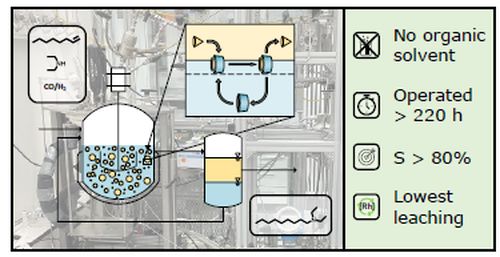 |
| Aqueous hydroaminomethylation (HAM) is an atom economic route for the efficient production of amines in one reaction step, starting from basic chemicals like alkenes. Herein we present the first successful establishment of a continuous process for a HAM in an aqueous multiphase system. The green mass transfer agents randomly methylated-β-cyclodextrins (CD) enabled the catalyst system consisting of rhodium/sulfoXantphos to achieve high yields of up to 70 % with selectivities of up to 80 % in several continuous experiments with a total run time of more than 220 h. The key here is that water and products have large polarity differences, but the reaction still proceeds effectively due to the addition of cyclodextrin, which made the application of solvents obsolete. The main achievements in this way were to investigate the influence of the randomly methylated-β-cyclodextrin concentration on the reaction rate and the selectivity in batch studies and find promising operating points in the first continuous experiments. In a final experiment, the separation temperature was investigated. It was shown that the catalyst loss into the product phase is enormously small at 0.003 %/h of the initial mass (0.24 % in total), which is the lowest ever reported value for the HAM on this scale. Within a run time of 78 hours, 2.87 kg of tertiary amine were produced using only 0.2 g (>14.000:1) of transition metal, while the loss of rhodium per kg of product produced was mostly around 0.15 mg/kg, suggesting possible economic applicability. |

- «Efficient removal of fluoride ions present in industrial effluents using metal-organic frameworks of UiO-66-NH2»
D. Lacalamita, G. Hoyez, C. Mongioví, A. Ponchel, N. Morin-Crini, C. Rousseau, C. Loup, J. Rousseau, M. Raschetti, E. Monflier, V. Placet, G. Crini
J. Water Process. Eng., 2023, 53, 103791 - doi: 10.1016/j.jwpe.2023.103791
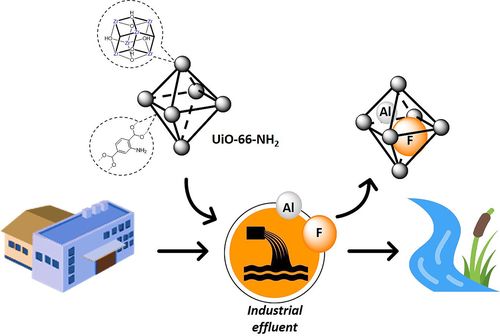 |
| In this last decade, numerous works have been published on the use of metal organic frameworks (MOFs) for applications in adsorption field to remove contaminants from aqueous solutions. However, little is known about MOFs as adsorbents for the removal of fluoride ions from real effluents. In this work, a highly porous MOF, UiO-66-NH2, was used for the final treatment of complex discharge waters containing fluoride ions from a surface treatment plant. Batch experiments showed that MOF exhibited high adsorption capacities towards fluoride ions, leading to concentrations under current regulation values. 70–80 % of the fluoride was removed in 60 min using 100 mg of MOF in 50 mL of effluent without changing the industrial initial pH. At the same time, the treatment also completely eliminated traces of aluminium in the discharge water. All the results showed that adsorption onto a non-conventional material such as UiO-66-NH2 can be an interesting tertiary treatment step to remove more pollutant streams from multi-contaminated industrial discharge waters. |

- «Application of cyclodextrins as second-sphere coordination ligands for gold recovery»
A. Ponchel, E. Monflier
Nat. Commun. 2023 14, 1283 - doi: 10.1038/s41467-023-36700-z
| |
| Supramolecular chemistry based on cyclodextrin receptors as second-sphere ligands contribute to developing non-covalent materials with synergistic functionalities. Herein, we comment on a recent investigation of this concept, describing selective gold recovery through a hierarchical host-guest assembly specifically built from β-CD. |

- «Exploiting poly(e-caprolactone) grafted from hydrohydroxymethylated sunflower oil as biodegradable coating material of water-soluble fertilizers»
A. El Mouat, T. El Assimi, M. Raihane, J. Ternel, H. Bricout, E. Monflier, S. Tilloy, M. Lahcini
Progress in Organic Coatings 179 (2023) 107513 - doi: 10.1016/j.porgcoat.2023.107513
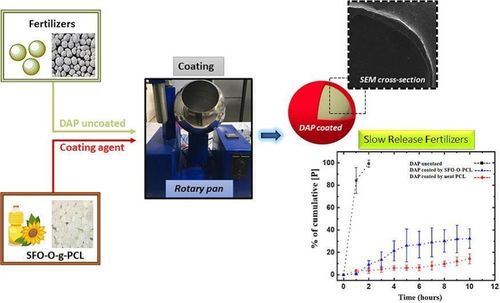 |
| In the present study, hyperbranched poly(ε-caprolactones) were prepared and used as coating materials to prepare slow release diammonium phosphate (DAP) fertilizer. Firstly, the sunflower oil was hydrohydroxymethylated by one-pot two-step process using Rh(acac)(CO)2 as catalyst, and triethylamine as ligand. Next, the bio-based hyperbranched poly(ɛ-caprolactone) (PCL) were prepared in open air by in-situ ring-opening polymerization of ε-caprolactone using hydrohydroxymethylated sunflower oil as macro-initiator and tetra(phenylethynyl)tin (Sn(C ≡ CPh)4) as catalyst. The structures of the prepared polymers (SFO-O-g-PCL) were confirmed by nuclear magnetic resonance (1H NMR) and the infrared spectroscopy (FTIR). Furthermore, molecular weight values around 20.000 g.mol−1 of PCL grafted in SFO-O-g-PCL were obtained, the thermal stability and morphology of the coated film were also evaluated using thermogravimetric analysis (TGA) and scanning electron microscopy (SEM) respectively. The hydrophobic character of the films prepared from SFO-O-g-PCL was confirmed by measuring the contact angle of water droplets. In the second part, the DAP granular fertilizers were uniformly coated by the prepared material (SFO-O-g-PCL) using a laboratory rotary drum. Then the slow release performance in water of the coated and uncoated DAP fertilizer granules was evaluated by tracking the cumulative concentration of P2O5 released. Thus, it was found that only 10 % of P2O5 was released after 2 h of essay from the coated DAP compared to a total release of P2O5 from uncoated DAP (conventional fertilizer) during the same period. This finding opens a wide perspective to combine the advantages of hydrophobic polyesters and bio-based oils to produce biodegradable coating agents. |

- «New Pyrochlore-like Oxyfluorides Na2-2xSnxM2O5F2 (M = Nb5+ or Ta5+ and 1 ≤ x ≤ 0) as Potential Candidates for Overall Water Splitting Photocatalysis»
E. Boivin, S. Saitzek, F. Fauth, M. Huvé, P. Roussel, H. Kabbour
Chem. Mater., 2023, 35, 2, 447–456 - doi: 10.1021/acs.chemmater.2c02801
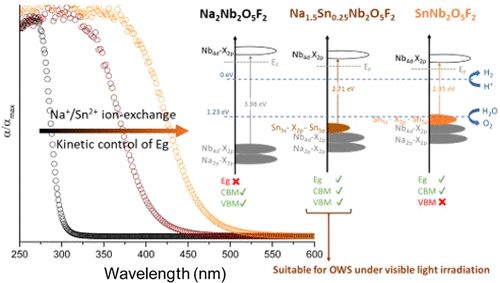 |
| Lone pair containing oxyfluorides have recently emerged as efficient and stable photocatalysts for overall water splitting (OWS). In this work we have obtained several new potential OWS photocatalysts with pyrochlore structure (i.e., Na2–2xSnxM2O5F2 with M = Nb5+ or Ta5+ and 1 ≤ x ≤ 0) through kinetically controlled ion-exchange reaction from Na2M2O5F2. Rietveld refinement of the structures as well as DFT indicate the Sn2+ lone pair stereochemical activity. The partial density of states reveals contributions at the top of the valence band that are mainly composed of a Sn 5s–Sn 5p hybridization through the (O,F) 2p orbitals. This leads to a significant narrowing of the band gap and an improvement of the photoconduction response by a factor ca. 50 with respect to the x = 0 compound, Na2Nb2O5F2. The Mott–Schottky measurements show that all materials possess band edge positions encompassing the thermodynamic redox potential of H+/H2 and O2/H2O. However, the valence band of SnNb2O5F2 may not be oxidative enough to overcome the overpotential associated with the O2– oxidation and hence could be unsuitable for OWS photocatalysis in contrast with Na1.5Sn0.25Nb2O5F2. |

Faculté Jean Perrin - rue Jean Souvraz - SP 18 - 62307 Lens Cedex
tel : 03 21 79 17 05
fax : 03 21 79 17 55 |






